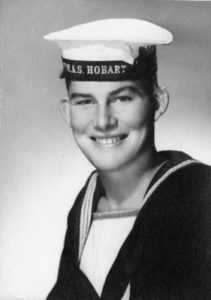Derek Holyoake enlisted in the Royal Australian Navy on July 8, 1940 at the age of 16 and was serving onboard HMAS Hobart when she was torpedoed on July 20, 1943. A quirk of fate resulted in Holyoake living and Able Seaman Albert Phillips dying. Holyoake, having just qualified as a torpedoman, had his action station moved forward from HMAS Hobart’s Y turret, the rearmost gun turret on the ship. Phillips, who had joined Hobart only a couple of months before, took his place.

The modified Leander class cruiser, a sister ship to the ill-starred HMAS Sydney and HMAS Perth, neither of which survived the war, was on patrol with HMAS Australia and three American destroyers, the USS Nicholas, USS O’Bannon and USS Radford, just south of the Solomons.
”It was 13 minutes to 7pm – how would I forget that time?” Holyoake said. ”In those days we always had one gun’s crew closed up in the turret. The changeover always took place at 6.50pm. The replacement gun crew, who would have just finished their evening meal, would wait for the crew that was already in the gun house to turn off the gun house lights [the ship would be blacked out], open the back doors and come out.
”My old crew, the four of them including my replacement, were sitting outside the turret on a Carley float waiting for the guys to open the door to let them out when a Japanese torpedo hit right underneath them, right underneath Y turret.”
The massive blast killed 13 men and injured seven others. Power and steering were lost for a short time and HMAS Hobart was left listing to port. The cruiser did not return to duty for 18 months.
”The torpedo was from a Japanese submarine. We were doing 25 knots and zig-zagging and this submarine sighted us against the afterglow of the setting sun from a range of 10 miles [16 kilometres]. He fired a salvo of torpedoes at the leading ship, HMAS Australia … We were the only one that got hit.”
The shot, one of the luckiest or unluckiest of the war depending on one’s point of view, was a remarkable testament to the quality of Japanese submarine service and its equipment.”The Japanese were just so good,” Holyoake said. ”They had the best torpedoes of WWII; you try and tell that to a navy officer and he’ll laugh at you, but they did …’If I had been at my previous station [that evening] I would have been killed. All those four crew I belonged to were dead.”
Holyoake was asked what effect the loss of his mates had on him by a student at a wreath laying ceremony at the Australian War Memorial in 2012. ” I thought to myself: ‘It affected us but we didn’t show it. How did we grieve? We didn’t.’ One of the guys was ‘Smithy’ [Able Seaman Alban Smith] and he ran an illegal SP bookie’s. All we were saying was, ‘Oh, bloody Smithy, going over the side with all that money’. He got blown over the side, you see. This was how we treated it.” The bravado masked a deep and personal sense of loss. ”That’s what you said but you felt it inside; you still feel it,” Holyoake said. ”Able Seaman Phillips, who took my place, he’d been on the ship only a few months and he’s dead. We weren’t counselled or anything like that; we just got on with it. Bad luck, somebody dies – but you still feel it inside.”
Holyoake had joined the navy at the behest of his father, who said ”you’ll be safe here”. Holyoake Jnr joined HMAS Hobart in January 1941 after she had returned to Sydney from service in the Gulf of Aden and the Red Sea. His first taste of combat came at Port Tawfik at the southern entrance to the Suez Canal on July 13 that year.”We had arrived to go through the canal and we had this tremendous raid,” he said. ”I was the loader on the four-inch [anti-aircraft] gun. We had German aircraft from about 1am to 4am. With the flash from the guns you couldn’t see what you were doing and it became a bit of a nightmarish situation. Then I heard this whining noise. I didn’t know what it was, and I said to the guy next to me, who was a bit of an old hand, ‘Heh, we shot one down’. He said ‘Oh, you silly bugger, it’s a bomb’. That was my introduction to WWII.” As part of the Mediterranean fleet, HMAS Hobart supported Australian and British forces, including the Diggers besieged at Tobruk, until December 1941 when the Japanese attacked.
Ordered home, the cruiser – and Able Seaman Holyoake – took part in the Battle of the Coral Sea and escorted troop convoy ships including the Queen Elizabeth and the Queen Mary. On her return to service in 1945 the ship supported the Allied landings at Tarakan, Borneo, and was in Tokyo Bay for the Japanese surrender on September 2, 1945.
Asked if he would ”do it all over again”, Holyoake observes that at 88 he is ”probably a little old”. ”Not now. Don’t forget, we were innocent and ignorant. I can say when we saw these troops up in Sydney Harbour when the troopships [Queen Mary and Queen Elizabeth] were tied up at Woolloomooloo and all these young soldiers were cheering and waving it was because they felt they were going to a big adventure. We felt the same thing. Little did they realise a lot of them wouldn’t be coming back, particularly the 8th Division going to Malaya.”
Original article was published in the Canberra Times on 13 October 2012




